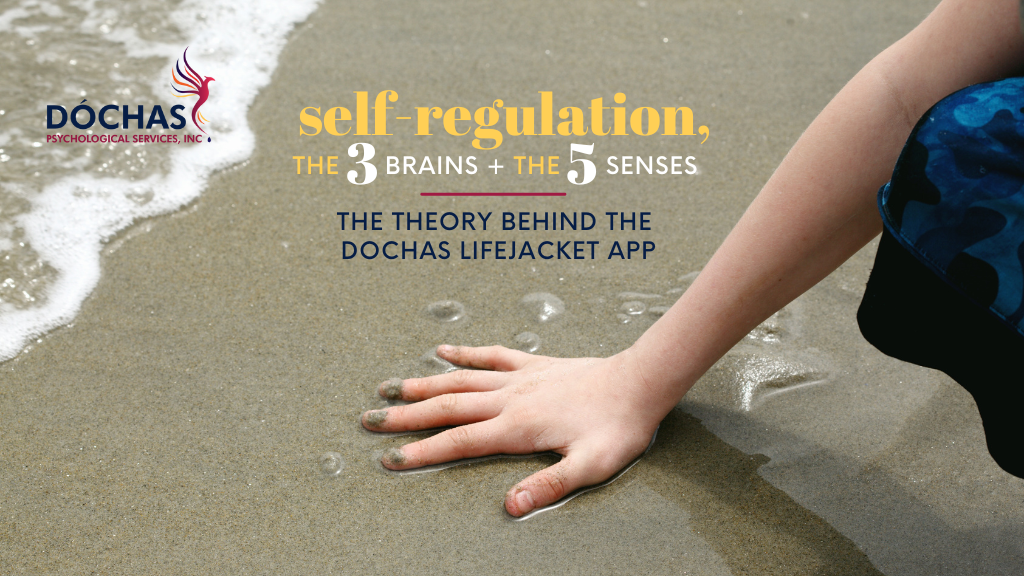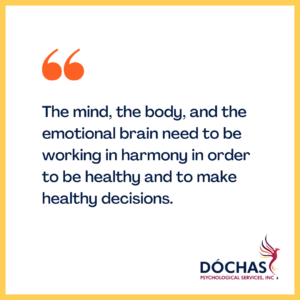If you tried out our Lifejacket App, or even just saw our social posts about it, you might be wondering about the research that inspired this app and how it works. So it made sense to do a deep dive on the theory behind this and explain the ideas that went into creating this helpful tool! It’s Kim on the Dóchas blog today, and I’m going to explain self-regulation, the three brains, the five senses, and how all these concepts work together.
You can watch the video below or read on to learn more!
So let’s dive into talking about how the five senses, the three brains, and self-regulation all work together in our ability to regulate ourselves and our emotions.
What is Self-regulation?
First, let’s start with self-regulation. Self-regulation is basically when our thinking brain is able to stay “online” when we’re experiencing something. This means our brain allows us to stay present in the moment, and not become overwhelmed and sink into fight, flight, freeze, or fawn reactions. This is helpful because then we’re able to stay present in our lives and remain fully functioning.
Now, that’s not always possible in every moment. As a psychologist, I do want clients to process their emotions and deal with their feelings and their body sensations without telling these feelings to go away or shut down. So you don’t want to use self-regulation all the time. But self-regulation can be really important when you’re in difficult situations, in order to survive them and make the best decisions that you can in that time.
Now, I mentioned self-regulation involves the “thinking brain”—what does that mean? This gets into the theory of the three brains, which I’ll get into next.
Our Three Brains and What They Are
I first heard about the three brains from Dan Siegel, who is a clinical professor of psychiatry, and he came up with the hand model of the brain. The hand model of the brain helps us visualize the brain and the different parts of the brain. We can think of each of these brain areas as a “brain” in and of itself. So here’s how the model works.
If you take your hand, your wrist is the spinal cord. Then the palm of your hand is the reptilian brain. It’s the oldest part of the brain, and it’s responsible for survival. I call it the body brain, just because it’s full of those instinctive responses.
Next, if you fold your thumb over, that’s the emotion brain. It’s where the amygdala is, and the amygdala is really the emotion center of the brain. It’s also involved in memory.
Now, if you fold your fingers over, it kind of looks like a small brain. Your folded fingers are the youngest part of the brain, the thinking brain. This is responsible for making stories and in language, and it’s the logical, thinking, self-regulating part of the brain.
The first two brain areas, the emotion brain and the body brain, are very similar. They don’t have language, and they respond to what’s going on in your environment to warn the thinking brain, “Hey, we might have to act!”
Sometimes what happens is that these two brains get really strongly triggered, or you end up with a bunch of chemical responses all in a row, and this overwhelms the thinking brain. The thinking brain flips off, and that’s when you kind of shut down, or lash out, or you do things that make you go “oops!” afterwards. And that’s because your thinking brain wasn’t online. It had shut itself down. So when I talked about self-regulation being about your thinking brain staying online, this is what it looks like when it’s not able to stay online.
And this is also why you sometimes can’t remember what happened during a trauma! The thinking brain was offline, and a major part of the thinking brain, the frontal lobe, is really important in being able to remember things, along with the hippocampus.
That’s a lot of information already, I know! So let’s sum it up.
The way I practice is I believe that the mind, body, and emotion brains need to be working in harmony in order to be healthy and be able to make healthy decisions. As part of that, self-regulation helps to keep the thinking brain online, and that’s why it can be important in certain circumstances.
The Five Senses
So now that we know all that, where do the five senses come in? The five senses come in because they can play a role in keeping that thinking brain online.
These two brains, the body brain and the emotion brain, are always scanning our environment. They’re taking in all sorts of information using—you guessed it, the five senses. The senses give us information about what’s safe, and what’s not safe. So our emotional responses are really guided by our senses.
Here are a few examples for different senses and how they connect to our emotional responses.
Smell: For me, if I smell liver, I’m instantly grossed out and want nothing to do with it. But my mom used to love liver, so she would smell it, and she’d have all these memories of down-home cooking and being with her mom. So smell can trigger positive or negative responses based on just that one sense and our memories that were connected with that.
Hearing: Think about when you hear the sound of a fire alarm. Instinctive response! You either need to run or attend to something.
Touch: You know that feeling of a light tickle on your leg? I instantly think a bug is crawling on me, because that happened to me as a kid. So this is another instinctive response.
There are also calming reactions we can have to information from our senses. Take music, for example. When music plays, especially if it’s music that we like, those vibrations trigger the brain and the body to release dopamine. Dopamine is the feel-good chemical. So it kind of gives us a high, so that we feel good.
And since sound is a really important sense for determining danger, music can be a wonderful resource for self-regulation because it releases that dopamine.
When we have a memory, there’s also all this sensory input that is part of the memory. This means that when we trigger the right sensations, we can trigger positive memories, which makes our body feel good.
What I would invite you to do now is to think about your five senses. Think about when you have a happy memory. What is the first sense that you remember as part of that? That might be your strongest sense. Now when you go to calm yourself emotionally, when you’re trying to soothe the emotion brain, you should use emotion strategies—the five senses. If your strongest sense is smell, for example, you are going to turn to things that smell. Specifically, things that smell good! Take advantage of how the five senses are tied into your instinctive responses, and when you need to calm yourself, use sensory input to trigger positive responses.
If You Need Some Help With This – Try the Lifejacket App!
For those of you who may be stuck on this, I invite you to download the Dóchas Lifejacket app. This app actually guides you with ideas for what senses to tap into when you’re feeling triggered. In that app we have a section where we ask you, what is your strongest sense? You pick the sense, and then it’ll come up with some strategies that are related to that sense. You just use it in any moment when you’re feeling overwhelmed.
You can get this app for free on the Apple store and the Google Play store. Feel free to check it out, try it out, and play with it. In the meantime, I know this has been a lot of information but I do hope that it helps you to figure out ways to soothe yourself when you’re really, really struggling! For those situations where you believe that you need your thinking brain to stay online and help that emotion brain out. By helping out your emotion brain you help your body brain and your thinking brain, since they all work together.
Experiment and see what you like and what you don’t like. And in the meantime, please take care of yourself. And as always, if you have any questions, just reach out, okay? You can reach us at 780 446 0300 or drop a line at info@dochaspsych.com.
About Dóchas Psychological
Dóchas Psychological Services is a well-established and trusted therapy clinic located in Spruce Grove, Alberta. At Dóchas we value the idea that everyone deserves a safe space. Through connection and education, our team works hard to build a trustworthy relationship with each of our clients. It is our goal to create a community for our clients to feel like they belong.
Disclaimer
Information provided through Dóchas Psychological Services blogs or vlogs is meant for educational purposes only. They are NOT medical or mental health advice. You can read more about our disclaimer here.




